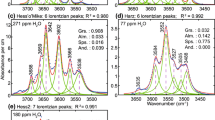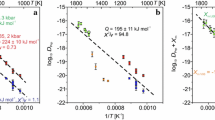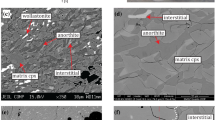Abstract
Diffusion couples made from homogeneous gem quality natural pyrope and almandine garnets were annealed within graphite capsules under anhydrous conditions at 22–40 kbar, 1057–1400 °C in a piston-cylinder apparatus. The concentration profiles that developed in each couple were modeled to retrieve the self diffusion coefficients [D(I)] of the divalent cations Fe, Mg, Mn and Ca. Because of their usually low concentrations and lack of sufficient compositional change across the interface of the diffusion couples, only a few reliable data can be obtained for D(Ca) and D(Mn) from these experiments. However, nine sets of D(Fe) and D(Mg) data were retrieved in the above P-T range, and cast in the form of Arrhenian relation, D=D 0exp{−[Q(1 bar)+PΔV +]/RT}. The values of the activation energy (Q) and activation volume (ΔV +) depend on whether f O2 is constrained by graphite in the system C-O or held constant. For the first case, we have for Fe:Q(1 bar)=65,532±10,111 cal/mol, D 0=3.50 (±2.30)×10−5 cm2/s, ΔV +=5.6(±2.9) cm3/mol, and for Mg:Q(1 bar)=60,760±8,257 cal/mol, D 0=4.66 (±2.48)×10−5 cm2/s, ΔV +=5.3(±3.0) cm3/mol. Here the ΔV + values have been taken from Chakraborty and Ganguly (1992). For the condition of constant f O2, the Q values are ∼9 kcal lower and ΔV + values are ∼4.9 cm3/mol larger than the above values. Lower temperature extrapolation of the Arrhenian relation for D(Mg) is in good agreement with the Mg tracer diffusion data (D * Mg) of Chakraborty and Rubie (1996) and Cygan and Lasaga (1985) at 1 bar, 750–900 °C, when all data are normalized to the same pressure and to f O2 defined by graphite in the system C-O. The D * Mg data of Schwandt et al. (1995), on the other hand, are lower by more than an order of magnitude than the low temperature extrapolation of the present data, when all data are normalized to the same pressure and to f O2 defined by the graphite buffer. Comparison of the D(Fe), D(Mg) and D(Mn) data in the pyrope-almandine diffusion couple with those in the spessartine-almandine diffusion couple of Chakraborty and Ganguly (1992) shows that the self diffusion of Fe and Mn are significantly enhanced with the increase in Mn/Mg ratio; the enhancement effect on D(Mg) is, however, relatively small. Proper application of the self diffusion data to calculate interdiffusion coefficient or D matrix elements for the purpose of modeling of diffusion processes in natural garnets must take into account these compositional effects on D(I) along with the effects of thermodynamic nonideality, f O2, and pressure.
Similar content being viewed by others
Author information
Authors and Affiliations
Additional information
Received: 8 May 1997 / Accepted: 2 October 1997
Rights and permissions
About this article
Cite this article
Ganguly, J., Cheng, W. & Chakraborty, S. Cation diffusion in aluminosilicate garnets: experimental determination in pyrope-almandine diffusion couples. Contrib Mineral Petrol 131, 171–180 (1998). https://doi.org/10.1007/s004100050386
Issue Date:
DOI: https://doi.org/10.1007/s004100050386




